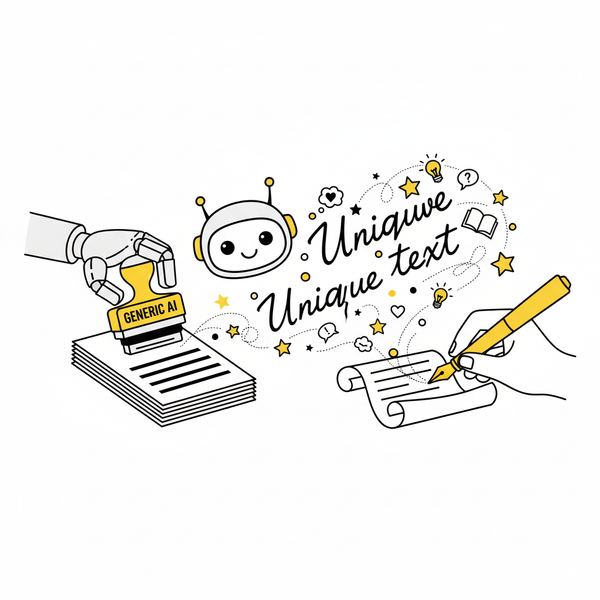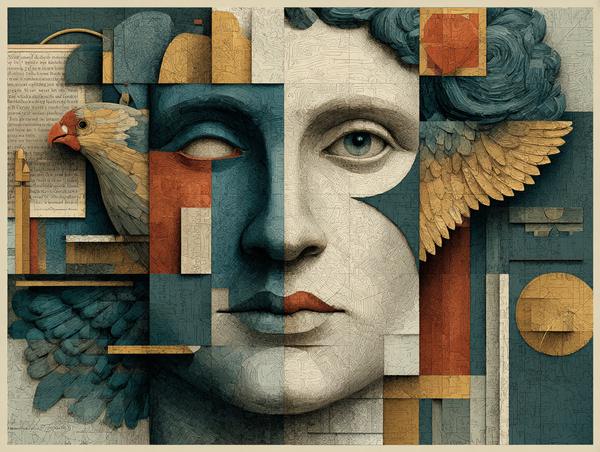Techniques for Deeper Idea Generation in AI Story Hub
Unlock AI's full brainstorming power in AI Story Hub! Go beyond basic lists with techniques for unexpected juxtapositions, counterfactuals, & more. Generate deeper, richer ideas for your universe in the Scratchpad!

You've discovered the power of AI Story Hub to help you structure your universe and generate content. But have you unlocked its full potential for brainstorming? Moving beyond simple prompts is key to generating ideas that are truly original, rich, and tailored to your unique story universe.
Basic list generation is just the starting point. To truly unlock the power of AI Story Hub as a creative partner for brainstorming, you need to go deeper. You need to push the AI, challenge it, and guide it towards unexpected connections and nuanced concepts within the context you've already built. This is AI Brainstorming on Steroids in AI Story Hub.
Let's explore some advanced techniques to elevate your brainstorming sessions beyond the basics, leveraging the structured environment and controllable AI of AI Story Hub.
Beyond Basic Lists: Pushing the AI for Deeper Ideas
Standard brainstorming prompts often yield standard results because AI models are trained to identify common patterns. To get something surprising or intricate, you need to prompt the AI to combine less common patterns, explore contradictions, or delve into hypothetical scenarios.
In AI Story Hub, understanding why this specificity matters is key: our AI models are designed to leverage the structured context you provide. The more precise your prompt, combined with the rich details from your characters, locations, and configuration files, the better the model can identify and combine the relevant patterns from its training data to match your unique request and generate something truly creative for your specific universe.
Think of AI Story Hub not just as a place to write, but as a versatile creative sparring partner ready to explore complex prompts using the foundation you've already built.
Advanced Brainstorming Techniques Leveraging AI Story Hub
Here are several techniques to generate deeper, more intricate ideas for your stories, enhanced by the tools available in AI Story Hub:
1. Play Devil's Advocate
Challenge your initial ideas by asking the AI to find their weaknesses or explore opposing viewpoints. This can reveal potential plot holes, force you to strengthen your concepts, or even spark entirely new directions based on the counterarguments. The Scratchpad is the perfect place to experiment with these challenging prompts without altering your main story files.
Prompt Idea (in Scratchpad): "Here is my core plot idea: [Briefly describe your plot]. Considering the established rules in my world [briefly mention a key rule], what are the three biggest logistical weaknesses of this idea? How could a cunning adversary exploit them?"
Prompt Idea (in Scratchpad): "Describe a compelling villain whose core beliefs are a twisted mirror image of my protagonist's virtues [mention protagonist's key virtue - AI Story Hub's character profiles can provide this context], yet logically flow from the story's world rules."
2. Generate Unexpected Juxtapositions
Force the AI to combine disparate concepts, genres, settings, objects, or characters. This is a powerful way to generate truly original ideas that don't fit neatly into existing molds.
Prompt Idea (in Scratchpad, maybe with specific Config Files active): "Generate 5 character concepts that combine traits of a [Character Archetype 1, e.g., stoic knight] with [Character Archetype 2, e.g., mischievous shapeshifter]. Focus on the internal conflict this creates, keeping in mind the genre constraints set in config.genre."
Prompt Idea (in Scratchpad): "Describe a specific object that feels completely out of place in its setting [describe setting or reference a Location file], like a [Object, e.g., neon-lit vending machine] in a [Setting, e.g., ancient, forgotten temple]. What is its story within this world?"
3. Explore Counterfactual Scenarios
Dive into "what if" questions, altering historical events (real or fictional), character choices, or fundamental rules of your world to see how things might play out differently. This is excellent for worldbuilding and generating alternative timelines or origins. Using the Scratchpad allows you to explore these divergent possibilities without affecting your main project timeline.
Prompt Idea (in Scratchpad, perhaps referencing a Timeperiod config): "In my fantasy world where a key prophecy [describe prophecy] failed to come true at the date set in config.timeperiod, how would the major political factions and religious beliefs have evolved differently over a century?"
Prompt Idea (in Scratchpad): "If my protagonist [describe protagonist, referencing their profile] had made the opposite choice at the end of [Key Event], describe three potential futures that could have resulted, each focusing on a different consequence for their established personality."
4. Develop Intricate Thematic Connections
Ask the AI to help you explore how themes, symbols, or motifs can be woven into your story elements in complex ways, suggesting concrete ways to show, not just tell, the theme. Keeping notes on themes in a dedicated Scratchpad file can be helpful here.
Prompt Idea (in Scratchpad, maybe referencing a Mood config): "My story explores the theme of [Theme, e.g., Isolation]. How could the recurring symbol of [Symbol, e.g., A broken compass] be used throughout the narrative to reflect different facets of this theme in various characters' lives [referencing character profiles] and the setting itself [referencing location descriptions], enhancing the mood set in config.mood?"
5. Simulate Character Dialogues & Group Interactions
Put potential characters or groups in hypothetical situations and ask the AI to simulate conversations or meetings. This can reveal character dynamics, generate natural-sounding exposition, spark plot points based on their interactions, or explore how different personalities clash or cooperate. AI Story Hub's Character Profiles and Dialogue Style settings provide essential context for the AI here. You can run these simulations in the Scratchpad.
Prompt Idea (in Scratchpad, with Characters defined): "Simulate a tense dialogue between Character A [mention their name] and Character B [mention their name] who have a shared, dark secret, meeting for the first time in years in [Setting]. Reference their established Dialogue Styles. What would be left unsaid?"
6. Prompting for Conflict Scenarios
Beyond just asking for plot ideas, focus specifically on generating different types of conflict and escalating them.
Prompt Idea (in Scratchpad): "Generate 5 distinct external conflicts that could arise for my protagonist [describe protagonist, referencing profile/flaw] based on their core flaw and the main challenge they face [describe challenge in the universe]."
7. Generating Unique Objects and Artifacts
Focus your brainstorming on tangible items that can drive plot, reveal lore, or serve as powerful symbols.
Prompt Idea (in Scratchpad, referencing a Location file): "Describe a magical artifact found in the location [mention location name]. What does it look like, what is its primary (and a hidden secondary) power, and what is its historical significance based on the lore established for this location?"
8. Exploring Abstract Concepts and Metaphors
Use the AI to generate metaphorical language or scenarios that represent abstract themes or ideas in your story world.
Prompt Idea (in Scratchpad, perhaps using a Tone config): "Generate metaphors or symbolic images for the theme of [Theme, e.g., The cost of progress] in a [Genre, e.g., Cyberpunk] setting, keeping the overall tone set in config.tone in mind."
9. Using Negative Constraints: Telling the AI What to Avoid
Sometimes, it's as important to tell the AI what not to do as what you want it to do. Using config.bannedwords sets persistent negative constraints, but you can add temporary ones in your prompt for brainstorming.
Prompt Idea (in Scratchpad, maybe with config.bannedwords active): ...Describe the ancient library. In this specific generation, also avoid mentioning stairs or books as the primary source of knowledge. Focus on [alternative source].
10. Prompt Chaining and Iteration: It's a Conversation
Think of prompting as a back-and-forth. The Scratchpad is ideal for this iterative process. Use the AI's output from one technique as input for the next prompt in the same Scratchpad file.
- Process Example (in Scratchpad):
- Prompt: "Generate an unexpected juxtaposition: Combine a space station with a haunted house."
- AI Response: (Provides ideas for a haunted space station).
- Follow-up Prompt (in same Scratchpad file): "Okay, using the concept of the haunted space station, play devil's advocate: Why wouldn't ghosts haunt a place with no history or life?"
- Follow-up Prompt: "Based on the challenges you just listed, brainstorm 3 alternative, non-ghostly reasons the space station might seem haunted (e.g., alien technology, psychological effects)."
11. Prompting for Specific Forms: Poetry, Scripts, and More
You can guide the AI to produce content in different formats, which can sometimes break you out of prose-based thinking and spark new ideas.
Examples (in Scratchpad):
Write a short script snippet (formatted) for a tense confrontation between Character A [name] and Character B [name] where no words are spoken – only actions and expressions, based on their defined personalities.
Unlock Deeper Creativity in AI Story Hub
AI Story Hub is more than a place to organize your finished thoughts; it's a dynamic environment for idea generation. By mastering these advanced prompting techniques and leveraging the power of the Scratchpad and your structured universe data, you can transform your brainstorming sessions into dynamic explorations. You can challenge your assumptions, discover novel connections, and generate a wealth of rich, intricate ideas to fuel your creative writing, all while keeping everything organized within your project.
Start pushing the boundaries of your AI conversations today in AI Story Hub and see what incredible ideas are waiting to be discovered. Practice these techniques in your Scratchpad, experiment with combinations, and document the surprising results right alongside your main story. The better you become at articulating your creative needs and guiding the AI within your structured universe, the more powerful your AI assistant will become in the idea generation phase.
Ready to take your brainstorming to the next level? Log in to AI Story Hub and open your Scratchpad!




